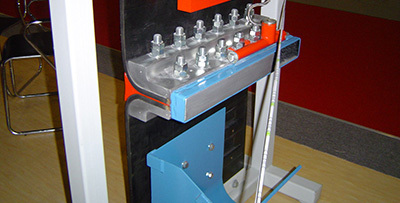News Center
Hezi technology focuses on the research and development of "rapid seamless conveyor belt joint sleeve" innovative technology project

NEWS CENTER

News Details
Why Rubber Belt Fasteners are Essential for Industrial Efficiency
Release time:
2024-12-30
Discover the pivotal role of rubber belt fasteners in enhancing industrial efficiency. Explore their types, applications, benefits, and expert insights to understand why these fasteners are crucial fo
Why Rubber Belt Fasteners are Essential for Industrial Efficiency
Table of Contents
- 1. Introduction to Rubber Belt Fasteners
- 2. Understanding Different Types of Rubber Belt Fasteners
- 3. Applications of Rubber Belt Fasteners in Various Industries
- 4. Key Benefits of Using Rubber Belt Fasteners
- 5. How to Choose the Right Rubber Belt Fastener
- 6. Installation and Maintenance Tips for Rubber Belt Fasteners
- 7. Common Issues and Troubleshooting Rubber Belt Fasteners
- 8. Conclusion
- 9. Frequently Asked Questions
1. Introduction to Rubber Belt Fasteners
In the world of industrial machinery, efficiency is paramount. **Rubber belt fasteners** play a critical role in ensuring that operations run smoothly, minimizing downtime and maximizing productivity. These fasteners secure rubber belts that are integral in various applications, from conveyor systems to automotive machinery. Their reliability and effectiveness can significantly impact overall operational efficiency.
2. Understanding Different Types of Rubber Belt Fasteners
Not all rubber belt fasteners are created equal. Understanding the different types available can help industries select the most suitable option for their specific needs.
2.1 Mechanical Fasteners
Mechanical fasteners are among the most common types used in industrial settings. They typically involve interlocking parts that secure belts without the need for additional adhesives. These fasteners can be easily installed and removed, making them a popular choice for applications that require frequent belt changes.
2.2 Adhesive Fasteners
Adhesive fasteners provide a more permanent solution. They involve bonding the belt material to a fastener using industrial-grade adhesives. While these fasteners can offer a stronghold, they may not be as easy to replace, making them ideal for applications requiring long-term solutions.
3. Applications of Rubber Belt Fasteners in Various Industries
Rubber belt fasteners are versatile components found in numerous industries. Their applications are broad and varied, adapting to the unique needs of each sector.
3.1 Manufacturing
In manufacturing, rubber belts equipped with fasteners are essential for transporting materials and products along production lines. Efficient rubber belt systems reduce the time taken to move items from one stage of production to another, contributing to higher output rates.
3.2 Agriculture
Agricultural industries utilize rubber belt fasteners in machinery such as harvesters and conveyor systems for transporting grains and other products. The durability of rubber belts ensures they can withstand the rigors of agricultural processes.
3.3 Mining and Quarrying
In mining, rubber belts are crucial for transporting mined materials. Fasteners that can endure harsh conditions are essential for maintaining the integrity of these belts, ensuring continuous operation and reducing the risk of equipment failure.
4. Key Benefits of Using Rubber Belt Fasteners
The adoption of rubber belt fasteners offers numerous benefits that contribute to industrial efficiency.
4.1 Enhanced Durability
Rubber belt fasteners are designed to withstand extreme conditions, including temperature fluctuations and heavy loads. Their durability leads to less frequent replacements, ultimately saving costs.
4.2 Improved Efficiency
By providing a secure fit for rubber belts, fasteners minimize slippage and misalignment. This directly translates to improved efficiency in material handling, reducing the time required for operations.
4.3 Simplified Maintenance
Many rubber belt fasteners are designed for easy installation and removal. This simplifies maintenance procedures, allowing for quicker repairs and reducing downtime.
5. How to Choose the Right Rubber Belt Fastener
Selecting the right rubber belt fastener is crucial for ensuring the longevity and efficiency of your machinery. Here are some key criteria to consider:
5.1 Material Compatibility
Ensure the fastener material is compatible with the rubber belt and the environment in which it will operate. Different materials offer varying levels of resistance to chemicals, heat, and wear.
5.2 Load Capacity
Choose fasteners that can handle the load requirements of your specific application. Overloading a fastener can lead to premature failure.
5.3 Ease of Use
Consider the ease of installation and removal. Mechanical fasteners may be preferable for applications requiring frequent adjustments, while adhesive fasteners may be better for long-term use.
6. Installation and Maintenance Tips for Rubber Belt Fasteners
Proper installation and maintenance of rubber belt fasteners are vital for their performance.
6.1 Installation Guidelines
Follow the manufacturer's instructions for installation. Ensure that the fasteners are securely attached, and check for proper alignment with the belt.
6.2 Regular Inspections
Conduct regular inspections to check for wear and damage. Early detection of issues can prevent more significant problems down the line.
7. Common Issues and Troubleshooting Rubber Belt Fasteners
Even with the best fasteners, issues can arise. Understanding common problems can help in troubleshooting effectively.
7.1 Slippage
If the rubber belt is slipping, check the tightness of the fastener and ensure proper alignment. Slippage can lead to increased wear on both the belt and the fastener.
7.2 Wear and Tear
Inspect fasteners for signs of wear. If they show significant damage, replacement is necessary to maintain operational efficiency.
8. Conclusion
Rubber belt fasteners are fundamental to achieving high levels of industrial efficiency. By understanding their types, applications, and benefits, industries can make informed decisions that enhance productivity and reduce operational costs. As technology advances, the role of these fasteners will only grow, underscoring their importance in modern manufacturing and industrial processes.
9. Frequently Asked Questions
1. What are rubber belt fasteners?
Rubber belt fasteners are components used to secure rubber belts in various industrial applications, ensuring efficient operation and minimizing downtime.
2. How do I choose the right rubber belt fastener?
Consider factors such as material compatibility, load capacity, and ease of installation when selecting a rubber belt fastener.
3. What are the benefits of using rubber belt fasteners?
Benefits include enhanced durability, improved operational efficiency, and simplified maintenance.
4. Are mechanical fasteners better than adhesive fasteners?
It depends on the application. Mechanical fasteners are easier to install and replace, while adhesive fasteners provide a more permanent solution.
5. How can I maintain rubber belt fasteners?
Regular inspections, proper installation, and timely replacements help maintain rubber belt fasteners and ensure optimal performance.

Recommend News





























